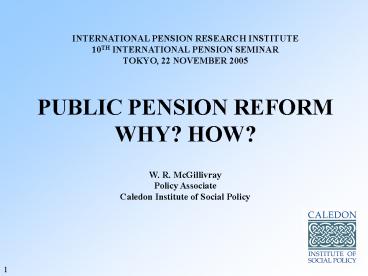INTERNATIONAL PENSION RESEARCH INSTITUTE - PowerPoint PPT Presentation
1 / 16
Title:
INTERNATIONAL PENSION RESEARCH INSTITUTE
Description:
winners/losers. social security = component of market economy. globalization challenges ... winners/losers are less obvious. 10. PARAMETRIC REFORMS. Three basic ... – PowerPoint PPT presentation
Number of Views:166
Avg rating:3.0/5.0
Title: INTERNATIONAL PENSION RESEARCH INSTITUTE
1
INTERNATIONAL PENSION RESEARCH INSTITUTE 10TH
INTERNATIONAL PENSION SEMINAR TOKYO, 22 NOVEMBER
2005 PUBLIC PENSION REFORM WHY? HOW? W. R.
McGillivray Policy Associate Caledon Institute of
Social Policy
1
2
POST WAR SOCIAL SECURITY IN INDUSTRIALIZED
COUNTRIES
- 1945-70 expansion
- during period of recovery/economic growth
- ILO Convention 103
- long-/short-term benefits
- 1970-90 consolidation
- during period of slower economic growth
- 1990 on reforms due to
- demography
- unsustainability
2
3
PUBLIC PENSION SCHEMES
Objective Provision of adequate income for a
retired person and his/her dependants which is
affordable, sustainable and sufficiently robust
to withstand potential economic or demographic
shocks.
3
4
PUBLIC PENSION SCHEMES
Pensions are transfers of resources from active
workers to inactive retired persons at the times
pensions are paid. Key to financing pensions is
economic growth Long term perspective necessary
4
5
SOCIAL SECURITY REFORM ISSUES
- governments
- have implicit/explicit social security
obligations - must ensure proper governance of schemes
- participants obligations
- social security schemes transfer resources
- ? political issue
5
6
SOCIAL SECURITY REFORM ISSUES (CONTINUED)
- take into account all social protection
programmes and their interactions - (including schemes covering public servants)
- governments can change schemes
- ? winners/losers
- social security component of market economy
- ? globalization challenges
- ? productivity implications
6
7
WHY REFORM?
- to ensure schemes objectives are met
- income replacement throughout retirement
- poverty avoidance
- income maintenance for disabled persons and
survivors - to remove abuses which
- increase the cost of the schemes
- have undesirable labour market/social
- implications
- to ensure the schemes sustainability
7
8
THE REFORM PROCESS
- proposals
- dissemination
- promotion
- discussion
- adoption
- implementation
- Risks
- reform deadlock
- complicated reforms
8
9
PENSION SCHEME REFORM
- DB schemes have long term obligations
- ? ratio annual expenditures ? for many years
- annual earnings
- government guarantees DB scheme
9
10
PENSION SCHEME REFORM
- types of DB pension scheme reform
- parametric (changing DB scheme)
- structural (replacing DB scheme)
- results of a pension scheme reform are long
delayed, hence - ? opportunities for obfuscation
- ? winners/losers are less obvious
10
11
PARAMETRIC REFORMS
- Three basic possibilities
- increasing the contribution rate
- cutting pensions, e.g. by
- reducing benefit accrual rate
- reducing cost of living adjustments
- reducing the number of pensioners, e.g. by
- increasing retirement age
- modifying conditions for receiving
- a pension
11
12
INCREASING RETIREMENT AGE
- great potential for reducing pension cost
- Japanese expectation of life at age 65
- Year Males Females
- 1960 14.8 17.8
- 2000 17.5 22.4
- 2050 (est) 21.3 28.6
- ? retirement periods are becoming longer
12
13
INCREASING RETIREMENT AGE (CONTINUED)
- ? working lifetimes can be increased
- (provided jobs are available)
- retirement age increases must be implemented
gradually - contracting labour force may require
- later retirement age in order to
- maintain living standards
13
14
EXAMPLES OF PARAMETRIC REFORMS
Increase contrib. Cut Reduce
no. rate pensions pensioners Canada X X Ge
rmany X X Japan X X X USA X
14
15
STRUCTURAL REFORMS
- generally adaptations of Chilean model -
- privately managed individual accounts DC schemes
- effect of reform cannot be known for many years
- governments are wary since under DC schemes
- individuals bear investment risk
- replacement rate is uncertain
- and governments will be held responsible
- if the income of their aged populations
- is inadequate
15
16
SOCIAL SECURITY REFORMS CONCLUDING OBSERVATIONS
- reforms are necessary to take into account
social, economic and demographic conditions - reform focus has been on sustainability but
must also pay attention to benefit
adequacy/equity - possibility of parametric reforms is a strength
of DB pension schemes - social consensus on reform is necessary
- social security beneficiaries have shared
- in improved living standards they must
- also share in potential declines in living
- standards
16

